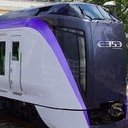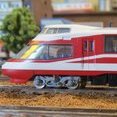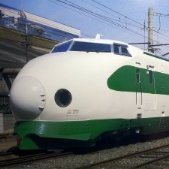Search the Community
Showing results for tags 'jr east'.
-

JR East Uetsu Main Line - Murakami to Atsumi-Onsen
miyakoji posted a topic in Japan Rail: Pictures & Videos
Another great front view video on JR East's own railfan channel TRAInBLAZER. At about 34:40, the train is entering a tunnel called 鼠噛. I can't find any references to this online, and I'm not sure how it's read, but it means mouse/rat bite. The following station is Nezugaseki, in which 'nezu' is the character for mouse/rat. Far out.- 3 replies
-
- 2
-

-
- jr east
- uetsu main line
- (and 9 more)
-
Here are a number of videos about the Oito Line, organized by season. These are from the Green Nova YouTube channel. They are extremely well done, essentially professional level production. JR East operates about two-thirds of the line, from Matsumoto to Minami-Otari, JR West operates the remaining distance to Itoigawa. Use the gear icon on the video’s toolbar to select English subtitles. Winter Spring Early Summer Autumn, parts 1 and 2 English Wikipedia page: https://en.wikipedia.org/wiki/Ōito_Line
-

Joetsu Cutter - snow/ice removal trains - English subtitles
miyakoji posted a topic in Japan Rail: Pictures & Videos
Great video with English subtitles explaining JR East’s use of electric locomotives and sometimes out-of-service EMUs to remove ice from the catenary. This channel Kaminakazato has a lot of good videos, I believe this is the first with English subtitles.- 2 replies
-
- 10
-

-
- joetsu line
- jr east
-
(and 2 more)
Tagged with:
-
Yikes. It says this is in Yaita City, Tochigi. I think it's the Utsunomiya Line between Kataoka and Kamasusaka. Japanese comments under the video are... extremely uncharitable :).
- 3 replies
-
- toritetsu
- bad behavior
-
(and 6 more)
Tagged with:
-

Tokaido Line train takes a wrong turn
miyakoji posted a topic in Japan Rail: News & General Discussion
On the morning of May 23 (JST), an inbound Tokaido line train was incorrectly routed onto the Tokaido Freight Line at a signal southwest of Ofuna. Apparently the decision was made not to reverse but to continue on. As a result, four stations were missed before the train arrived at Musashi-Kosugi. If I'm reading maps correctly, it was the Tokaido Freight Line for most of the distance, but also the southeastern freight-only portion of the Musashino Line from around Tsurumi to Musashi-Kosugi. JR East yards will be thoroughly weeded for months to come. I imagine that the driver would have been surprised at the signal routing the train onto the freight line. I also imagine the railroads having a procedure for everything. Was it to follow the routing, even if it was not what he expected? A handy explanatory video was made by Ayokoi. If you enable Japanese subtitles in the video, you can then set it to autotranslate to the language of your choice (I did this on the desktop site, not in an app).- 6 replies
-
- 4
-

-
- jr east
- tokaido line
-
(and 3 more)
Tagged with:
-
LAYOUT DIARY START I thought I'd slowly document the process of making my first layout. This post contains an overview of the final model. Other sections I've written or plan to write are: Planning Process Hills, Roads and Tracks Buildings Detail Station Lighting I bought my first train last year - a bright yellow n-scale Kato Sobu 101 - and was looking for inspiration for a new layout to build around it. I needed something relatively modest, since this would be the first one I've constructed and I didn't want to set myself up for over-achievers failure, creating more work then I had the time or inclination to put myself to. I've been obsessed with Japan since living in Yokahama as a very young child. Clearly my purchase of the Kato was part of this obsession, and I was keen to build some (probably poor) approximation of a Japanese environment around it. The Sobu train runs on the Seibu Kokunbunji line in Tokyo, so I followed the route on Google Maps looking for an area that I could use as a subject. Eventually, I found a small, pedestrian-feeling street called Takenodai Ekidori in the west of the city, which I've used as the basis for this layout. I've tried to copy the houses quite accurately, and the general layout of the area a bit more freely. The street itself is longer, and Takenodai Station is a bit larger than I planned, so I've created a fictional station of my own. I've been working on this layout for a while now, so I'm late in terms of posting progress here. Sorry. I thought I'd use this first post to show where I am right now with construction, then use a few subsequent posts to go back through some of the process, then show a bit more detail as I finish up. Comments and feedback very welcome, although obviously I'm pretty committed at this point since I'm about 80% of the way through! 🙂 So here's where I am now. This model is a 240cm by 27cm "shelf" layout. I just ended up with those dimensions based on my decisions of what track length to use, and how much of the street I wanted to copy. It's electrified, with one point. The street basically runs along one side, with a small rise on the other. Here's a video of the whole layout, and a bunch of shots. At this end of the layout is a small canal, crossed by the street and the track. The station entrance is scratch made, with stairs that rise up to a Kato Suburban station. A row of small shops and restaurants line the street. These are all scratch made, based on images that I captured through Google Street View (I'll get into the process of this in a later post). Here are some general macro shots of different parts of the layout. I've used LED-based street lighting along the length of the street, and dismantled a few of the lamp posts in order to build lighting into the shops and the station. The various cars and buses also have lights in them, although they need different power to the other LEDs, and I haven't quite figured out how to manage that yet. The LEDs are pretty effective in the station (since I took this shot I've closed off the visible gap at the bottom of the station columns, so they're a little cleaner). The mix of warm and cool LEDs seems to create a realistic effect, although it was a happy accident after buying two seperate batches of street lamps that didn't match. I've lit most of the shops from within, too. Here's a YouTube video of the layout "at night". Anyway, that's where I'm at. I still have a bunch of tidying up to do. More greenery to add, as well as people. The sides need painting, and possibly more road markings and signs. If anyone has suggestions for small details to add I'd love to hear them. As I mentioned above, I'll put together more detail and photos about the process I went through to get to this point in subsequent posts. If anyone has any specific questions please let me know. Next: Planning Process
- 20 replies
-
- 13
-

-
- nscale
- tokyo metro
-
(and 3 more)
Tagged with:
-

JR East announces KiHa 130-500 series and GV-E400 series
Densha posted a topic in Japan Rail: News & General Discussion
Alongside the new Shinkansen test train, JR East has announced the KiHa E130-500 for use on the Hachinohe Line. The first units of these will be delivered in August this year, out of a total 18 cars having been ordered. (Source: http://railf.jp/news/2017/07/04/165500.html) JR East has also announced a prototype of 3 vehicles of the GV-E400 series, a diesel-electric (?) multiple unit train. The mass-production units of this series will be introduced on the Uetsu Main Line, Shin'etsu Main Line, Yonesaka Line and Ban'etsu West Line in the Niigata region in 2019. In 2020 they will be introduced on the Tsugaru Line, Gono Line and Ou Main Line in the Akita region. (Source: http://railf.jp/news/2017/07/04/170000.html) -

JR Hokkaido, JR East, Tokyu Dentetsu to cooperate on running summer Hokkaido tourist trains
bikkuri bahn posted a topic in Japan Rail: News & General Discussion
JR East will loan a diesel railcar set for use on the Soya Line, while Tokyu will provide the Royal Express trainset which will be used on a yet undetermined itinerary from Sapporo to Eastern Hokkaido. The Royal Express is a DC EMU, so in AC and unelectrified JR Hokkaido territory, it will be pulled by a set of diesel locomotives coupled with a generator car providing hotel power.- 20 replies
-
- 1
-

-
- jr hokkaido
- jr east
-
(and 4 more)
Tagged with:
-
Here's a very well made video by jitensya37 about the history of the area around Shiojiri Station. Thanks to some clear maps and years written in the western system, this video is understandable and enjoyable. Shiojiri Station's history starts in 1902 under JGR, at this point specifically the Ministry of Railways. The video shows various line alterations over the years including the relocation of the station building in 1982 as well as a walk around the neighborhood. It became JR East territory in 1987 and is also the administrative border with JR Central's portion of the Chuo Line running southwest to Nagoya. jitensya37's other videos: https://www.youtube.com/user/jitensya37/videos Google map centered on Shiojiri Station: https://www.google.com/maps/@36.1134192,137.9493623,14.75z Wikipedia: https://en.wikipedia.org/wiki/Shiojiri_Station Wikipedia map of lines: https://ja.wikipedia.org/wiki/ファイル:岡谷・辰野・塩尻付近_JR路線図.svg The excellent Senro Haisenzu blog also has several entries for Shiojiri. Included are track diagrams and old photos: December 25 1978 pts 1 and 2: http://senrohaisenzu.cocolog-nifty.com/blog/2008/02/19781225_adaf.html http://senrohaisenzu.cocolog-nifty.com/blog/2016/05/19781224-bd4d.html May 1 1988 pts 1 and 2: http://senrohaisenzu.cocolog-nifty.com/blog/2016/05/198851-d36d.html http://senrohaisenzu.cocolog-nifty.com/blog/2016/06/198851-086c.html May 1 2002 pts 1 and 2: http://senrohaisenzu.cocolog-nifty.com/blog/2009/07/200251-1-3877.html http://senrohaisenzu.cocolog-nifty.com/blog/2009/07/200251-2-a1b8.html
-
- 7
-

-
- shiojiri station
- jr east
-
(and 5 more)
Tagged with:
-
Thought I'd share this youtube video that has many JR East ATOS announcements in it, and it only has the voice of Eiji Tsuda, the old voice, so you can listen to him to your heart's content! I think he was getting old, so that's why they got rid of him? Because the lack of English wouldn't have been a problem, as you can see in here, they just stuck the female English voice at the end.
-
Missed the announcement on this one, didn't see it on the JNS forum either when I searched for Kairi Started running 5th of October between Niigata and Sakata https://www.jreast.co.jp/e/joyful/kairi.html
- 6 replies
-
- 4
-

-
- kairi
- joyful train
-
(and 1 more)
Tagged with:
-

ATO to be introduced on the Joban Line Local
RossDensha posted a topic in Japan Rail: News & General Discussion
By the end of 2020 JR East plans to have ATO (Automatic Train Operation) on the Joban Line (Local) between Ayase and Toride where there is already ATC. They're hoping that it will help develop autonomous trains. Platform doors will also be installed after the introduction of ATO, which will increase safety on this line. JR East Press Release here: https://www.jreast.co.jp/press/2019/20191008_ho03.pdf -
I came across this, very interesting, video in my youtube recommended list. Cab ride from Ueno to Sendai on the Tōhoku Shinkansen: The landscape around the Tōhoku shinkansen has off course changed considerably over the last 30 years, both in terms of the railway(s) themselves as the surrounding architecture, having been caught up in the unstoppable march of progress. Yet it still remains highly recognizable, especially around the stations. Interesting things, imho, to notice: - Keihin-Tōhoku line 103 series. At this point in time JR East was already working on the design of the 901 series prototype, which would become the 209 series. They would replace the ageing 103 series fleet between 1993 and 1996. - Saikyō line 103 series. An interesting mix of ex-Yamanote line high cab 103 series formations, all kinds of mixes between fully air conditioned formations and everything inbetween. Would be replaced by new built 205 series in 1990. - Construction work at Fukushima station, the Yamagata shinkansen was under construction (conversion would be the better word though) at that point in time, and would open in 1992. - While the 400 series shinkansen was being designed at that moment, at that point the only series used on the eastern shinkansen was still the 200 series. - While the majority of the formations met along the way were al F formations (Either F1~F3/F4~F21 sub group (New built) or F41~F41, F51~F59 (converted former E formations) sub groups) I noticed at least one G formation (Though whether this was a G20~28 or G40~G48 sub-formation was impossible to discern) and one of the few remaining E formations. It also gives a valuable insight, to me at least, into the operation of the Tōhoku Shinkansen in the period after the split of the old national railways (J.N.R.), only 2 years and a few months after it occurred. In June 1989, when this was filmed, the Tōhoku Shinkansen had been in operation for close to 7 years. Originally opened on the 23rd of June 1982, the Tōhoku shinkansen was the 3rd shinkansen to open during the national railways era. It was part of the 1971 Shinkansen construction plan, which also included the Jōetsu Shinkansen (opened on the 15th of November 1982) as well as the cancelled Narita Shinkansen (cancelled in 1983). Though designed around a maximum operational speed of 260km/h, the maximum speed at the time of the opening of the line was set to 210km/h, the same as on the Tōkaidō/Sanyō Shinkansen pre 1986. The full route of the Tōhoku shinkansen was always planned to run between Tōkyō station and Morioka, however due to the 1970's oil crisis as well as the deteriorating financial situation of the national railways, it was decided to open the route in stages. During the opening of the Tōhoku Shinkansen, only the section between Ōmiya and Morioka had been finished, while work was still continuing on the section between Ueno and Ōmiya, while work had yet to commence on the section between Tōkyō station and Ueno. The section between Ueno and Ōmiya was opened on the 14th of March 1985. At the same time the maximum operational speed, on both the Tōhoku and Jōetsu Shinkansen, was increased from 210km/h to 240km/h, which made it the fastest Shinkansen at that point in time. While the 200 series was originally designed around a maximum operational speed of 250km/h, the first 5 batches (the E formations, E1~E36 delivered between late 1980 and 1982) were limited to a maximum speed of 210km/h. This was because of the MM+MM' (1 pantograph per 2 cars, i.e. 6 pantographs per 12 car formation) layout they shared with the 0 series Shinkansen. With contact noise being a large part of the noise footprint generated by the shinkansen (in 1974, residents along the Tōkaidō Shinkansen had filed a lawsuit against J.N.R. because of the noise pollution generated by the 0 series (the only series operating at the Tōkaidō shinkansen at that point in time) formations running at speed. As a result, new standards for noise pollution were passed in 1975 limiting the maximum sound level permitted to 75db in build-up areas. Though it would still take almost a decade before actual action were taken to reduce the noise on the existing lines), as well as the overhead line swaying caused by the passing of a pantograph resulting in loss of contact for the upcoming pantograph at high speed. In order to allow a future increase in speed, the 200 series cars built from batch 6 onward (1983) would be fitted with a high voltage through cable near the roof of the car. This allowed the number of active pantographs to be reduced to 3 (from ~1993 onward only 2 would be in use, with the two forward pantographs used as reserve, while the redundant middle ones (cars 6 and 8 on the F formations, 6 on the post 1997 K formations and cars 6 and 12 on the 16 car H formations) were removed) and therefore, with changes to the ATC, they were capable of running at a maximum operational speed of 240km/h. While the first 3 new formations were originally numbered consecutively to the existing E formations (E1~E36) as E37~E39, because of their different operational capabilities they were quickly renumbered into a new sub group of formations, the F formations (F1~F3) while their cars would be numbered into the 1000 sub-type range of the 200 series. For the production batches 7 onward, another small change was made to the design of the series. For the scheduled opening of the section between Ueno and Ōmiya, it was projected that the ridership on the line would increase. As a result, the interior of the type 221 and 222 end cars were slightly redesigned to allow the addition of an extra row of standard type seats in both of them (adding 5 seats per end car). As a result of this, the end cars were numbered into the 1500 sub-type range of the 200 series, the middle cars remained in the 1000 range. All remaining batches, 7~9 would be delivered with 221/222-1500 sub-type cars between 1984 and 1985, they would be part of the F4~F21 sub-group of formations, the last 200 series formations to be built. Which brings us to the formation this video was shot in. According to the description, this was filmed in the cab of 222-1512 which, if the information correct (footage at the end of the video reveals part of the formation number (4) from the observer side of the cab, which could only be formation F4 (or, translated from geek speak, the number 4 seems too close to the second wiper on the right to be F14), which would make it 222-1501 as opposed to 1512... It is off course possible that they filmed this part of the material separately at a different time and they are unrelated) means this was filmed in 200 series formation F15. Formation F15 was completed by Nipon Sharyō on the 20th of November 1984 as part of production batch 8, the second to last production batch for this series. In June of 1991, as with all remaining F formations, her green car changed position within the formation, changing from position 7 to position 11. In March of 1997, as part of the increase in K formations formed needed for the opening of the Akita Shinkansen in the same year, she would be reformed into formation K48. This group within the K formations, K41~K51, were the first to contain 10 cars as opposed to the 8 cars of the original K formations (K1~K11). The remaining 2 surplus cars were then used to extend the 8 car K1~K11 sub group into the 10 car K21~K31 sub-group of formations. The remaining cars of F15 (225-1030 and 226-1074) would be added to formation K6, which would continue as K26. In December 1999, K48 was the 4th K formation to undergo life extension and renewal work, K26 would follow a year later in December of 2000. While this renewal was meant to extend their life for another 10 years, most would actually serve beyond this 10 year benchmark. When the 200 series retired from the Tōhoku shinkansen in November 2011, K48 was the first of the renewed formations (with exception of formation K25 which was severely damaged after a derailment during the Niigata-Chūetsu earthquake in 2004) to be retired and scrapped, exactly 27 years after she was built. K26 would soldier on for a little while longer, being transferred as one of 8 K formations designated for the Jōetsu shinkansen, she was finally retired in January 2013, 2 months before the scheduled retirement of the last 200 series shinkansen. 225-1030 and 226-1074, the last remaining cars from formation F15, would serve for slightly more than 28 years. Please enjoy!
- 3 replies
-
- 7
-

-
- shinkansen
- 200 series
-
(and 3 more)
Tagged with:
-
After a prolonged absence the webcam (with sound) or the Tokaido line and Yurikamome tracks near Shiodome is working again
-
Hello everyone! Today marks one of the first days that I've begun work on an actual (hopefully) N-Scale layout! As these first two pictures demonstrate, I finally arranged a deal to get some space for a small layout, which at the moment is 16' × 2' (really only 20", because of the upper shelf support poles.) Eventually, when time, useable space and family permit, I have plans to expand it into a reversed 'F' shape, through the use of additional shelves along a different wall, and a heavy duty wooden center island table left over from some HO-scale projects. The shelving on the rear wall will the be top part of the letter 'F', and will add about 11' by 2' (again, only 20" of that useable). Final dimensions of the center island table TBD. (Possibly 5' × 6'?) I'll try and post the potential track plan(s) later tonight! I am also always open to feedback, so please chime in, it might really help me out! Thanks for your interest! ~Phillip R.
- 113 replies
-
- 10
-

-
Hello all, after a bit of silence on my behalf, here is the excuse for my absence. A trip to Kinugawa in Tochigi and after that to Ibaraki, the usual place and then some. Kinugawa no. 5 just arrived in Shinjuku. 253-1000 Series, big time baller. Massive chairs. Weird livery, which I slowly start to appreciate. Some train from the window we overtook. With advertisement. I don't know what this thing is. Yours truly and mini-yours truly. Brainwashing completed. "Look dad! A train!" "Yes, that is probably the 10th Keihin-Tōhoku line train we've seen already..." First encounter with an Aizu Railway train. AT-600 and AT-700 type. My excitement was all over the place. The trip on the JR East Kinugawa was most pleasant. If possible, I'd ride it again, but only to go beyond Kinugawa-Onsen station to Aizu Wakamatsu station. The view from the hotel room was... Well, let's say: almost perfect. Another exciting encounter was had a few days later with the seasonal rapid Ashikaga Ōfuji Matsuri-gō, ran by a 485 Series, T18 formation. Probably for one of the last times this formation runs. One end of the train is an Hokkaidō styled front with double roof lights. Very macho. xD Next to that, the Kasama Hi Matsuri-gō Rapid service ran with an E531 Series. Special headmark included. I actually didn't know this one was running, so I was very surprised to see it! In the attachments are some extras that aren't really worth mentioning, but are still interesting enough to share. A bad snapshot of the recently repainted Tōbu 100 Series Spacia 101 formation is included as well. Yes. It's gold. Like Spandau Ballet. The Tōbu 6050 Series also almost stole my heart, but my finances and rationale keep me at bay from liking it. This trip has however seriously triggered my interest in creating hillside scenery. P.s. Don't like my filthy hipster filters over some pictures? Feel free to donate a good digital camera. PM me if interested.
-

E231-3000 series to start running on the Hachiko Line
Densha posted a topic in Japan Rail: News & General Discussion
As a test run today pointed out, it looks like we will be seeing E231s on the Hachiko Line in the near future. These are former B5 formations renumbered into the E231-3000 subseries.- 8 replies
-
- 2
-

-
- e231 series
- jr east
-
(and 1 more)
Tagged with:
-
 Hello everyone, We have released the new FREEWARE content, Tokyu 9000 series. With detailed interior & exterior as real as realistic, animated door. You don't need to pay for this content! Download Now
Hello everyone, We have released the new FREEWARE content, Tokyu 9000 series. With detailed interior & exterior as real as realistic, animated door. You don't need to pay for this content! Download Now -
Part of a former JR East 583 series will be preserved in the railway museum in Taipei. Strangely enough, it concerns only intermediate cars MoHaNe 582-106 and MoHaNe 583-106. Source: https://response.jp/article/2017/11/20/302721.html
- 2 replies
-
- 1
-

-
- 583 series
- jr east
-
(and 2 more)
Tagged with:
-

Yamanote Line E235 Automatic Station Annoucements
bill937ca posted a topic in Japan Rail: Pictures & Videos
A video dated March 15, 2016 of the E235 Series station announcements in both Japanese and English. -
Speaking theoretically starting from Tokyo-eki with a ¥200 ticket, how long could you theoretically stay "in-the-system" without leaving through a single fare-gate or ticket booth--in essence "live in the JR-East system" (not specifically Tokyo-Eki or any other single station)? Just to make it fun, I've added a poll. For even more fun, let's see if someone will actually try it ^_^
-
With the upcoming opening of the Ueno Tokyo Line, JR East has announced the special trains (rinji ressha) typically running on weekends and holidays, that will utilize this route: -Ltd. Express Odoriko 161/162 Abiko to Izukyu Shimoda and return, 7 or 10 car 185 series -Express Burari Yokohama/Kamakura-go Iwaki to Kamakura and return, 7 car 651 series -Ltd. Express Kinugawa 92/93 Ofuna to Kinugawa Onsen and return, 6 car 253 series http://news.mynavi.jp/news/2015/01/23/312/
- 2 replies
-
- 1
-

-
- jr east
- ueno tokyo line
- (and 7 more)
-

JR East makes initial announcement thru-running on Ueno-Tokyo Line
bikkuri bahn posted a topic in Japan Rail: News & General Discussion
This Thursday JR East announcened preliminary plans for through services on the Ueno-Tokyo Line which is scheduled to open this March. Summary as follows: 1. Utsunomiya and Takasaki Line trains will run through on the Tokaido Line south of Shinagawa. 2. Joban Line trains will terminate at Shinagawa. 3. During the 8~9am peak, 5 up trains from each of the three lines will operate over the line. *however, the Joban Line through trains will only be rapid services originating at Toride. 4. All off-peak ltd express services from the Joban Line will terminate/originate at Shinagawa. Likewise a portion of services will do so in the evening peak period. 5. Off-peak a portion of Joban Line local services originating in Tsuchiura will terminate/originate at Shinagawa, and in the evening peak, rapid services for points south of/to Toride will terminate/originate at Shinagawa. 6. Two limited express services will be introduced on the Joban line, the Hitachi will be configured as a limited stop service, while the new Tokiwa service will have more stops. These services will introduce a simpler limited express tariff system, as well as existing ticketless service using smart/mobile phones. http://www.jreast.co.jp/press/2014/20141022.pdf *in the TV news report, it was stated that almost all up direction Tokaido Line trains will continue on to Ueno (and beyond?), presumably as either Utsunomiya or Takasaki Line services.- 14 replies
-
- 1
-

-
- jr east
- ueno-tokyo line
- (and 4 more)
-
Hello there. I am a Filipino railfan. I would like to know the specs of the Kiha 52 and Kiha 59. Thanks
- 3 replies
-
- philippines
- kiha 52
- (and 5 more)
-
Railway Safety Slipping? The Tokyu Toyoko line rear end crash and now this?! Apparently at 1:11 on the morning of the 23rd an out of service 10 car keihin tohoku line train appears to have struck an engineering works trolley at Kawasaki (looks from photographs like overhead line equipment). The impact overturned the first car and derailed two others. The conductor (34) and driver (25) both escaped with minor injuries. The accident has resulted in the suspension of operations between Kamata and Tsurumi stations. See photos and full article at from Asahi: http://www.asahi.com/articles/ASG2R0J1WG2QUTIL01W.html More ATC issues?
- 13 replies
-
- keihin tohoku line
- accident
-
(and 1 more)
Tagged with:

.thumb.jpeg.f884771be9f2863f4bd58c7cef6ed4e7.jpeg)
























































